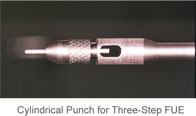A significant advance in Follicular Unit Extraction has been the addition of “blunt” dissection to the original technique of “sharp” dissection followed by extraction. This was described by Dr. Harris at the International Society of Hair Restoration Surgery (ISHRS) in 2004. In this three-step technique, a sharp punch is used to score the epidermis (cut just the upper part of the skin) and then a dull punch is used to bluntly dissect (separate) the follicular unit grafts from the surrounding deeper dermis. The third step is the same, namely removing the follicular graft from the scalp using fine forceps.

At Bernstein Medical a proprietary dissecting instrument is used that allows us to efficiently perform this 3-step technique with minimal transection. The instrument is positioned around the scored upper part of the follicle allowing the surgeon to remove the entire follicular unit from the scalp. This new design was presented at the ISHRS meeting in Sydney, Australia and published in Hair Transplant Forum International (see Dr. Bernstein’s publication, “New Instrumentation for 3-step Follicular Unit Extraction“).
- More about Follicular Unit Extraction
The advantage of this hair transplant technique over the original two-step process is that using a dull punch minimizes follicle transection (damage). As the blunt-tipped punch is advanced into the dermis, the follicles, which naturally separate deeper in the skin, are “gathered together” within the opening of the instrument, rather than risk the lower portions of the follicles being cut off. Another significant advantage of the new technique is that it increases the number of patients who are able to benefit from FUE.
A problem of the three-step technique, however, is a higher incidence of buried grafts. When a buried graft is identified, it can sometimes be extracted by applying pressure to the surrounding skin. If this maneuver fails, a small incision is made to enlarge the opening and facilitate the removal of the graft. If not removed, a buried graft can occasionally result in a small cyst that would need to be removed at a later date.
Another problem is that during the extraction attempt the epidermis and upper dermis may separate from the rest of the follicle. This phenomenon has been called “capping.” When this occurs, the lower portion of the graft can sometimes be grabbed and extracted. When this is not possible, the lower potion is simply left behind. In this case the wound will heal and the lower portion of the follicle should produce a new hair.





